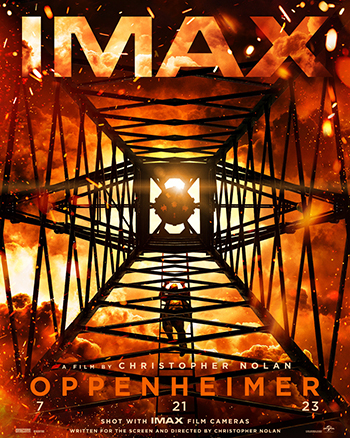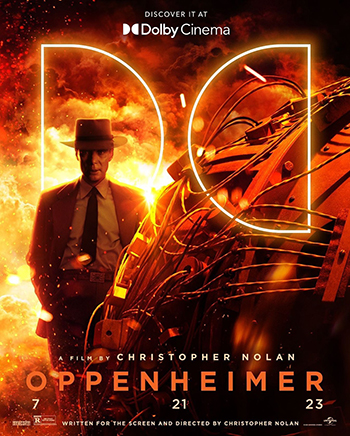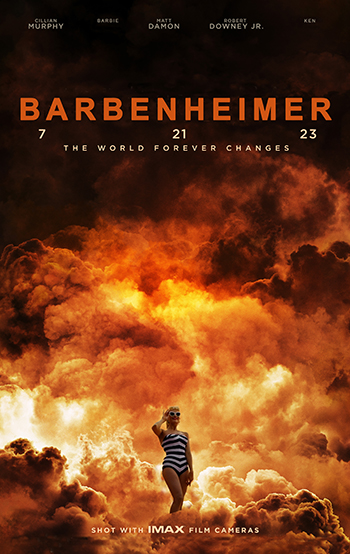Movies

New Releases • A-D • E-H • I-P • Q-Z • Articles • Festivals • Interviews • Dark Knight • Indiana Jones • MCU
Go behind the scenes of Oppenheimer with director Christopher Nolan and cinematographer Hoyte van Hoytema
Featurette: Universal Pictures
Oppenheimer: On Film and in IMAX
#Oppenheimer • #IMAX • #70mm
A lot of movies these days are shot digitally then formatted for IMAX screens. More are starting to film key sequences in the extra-large format. Regardless, consider Christopher Nolan as the father of mainstream IMAX filmmaking.
Taking (Film) Stock
It all began with Batman Begins getting an IMAX release. Then The Dark Knight had its prologue – featuring Heath Ledger as the Joker – filmed with IMAX cameras and presented as a standalone teaser released with Will Smith’s IMAX theatrical release of I am Legend.
From there, Nolan has consistently pushed the boundaries and removed barriers, starting with cinematographer Wally Pfister and continuing now with Hoyte Van Hoytema.
Oppenheimer represents the next level, but that’s an understatement.
With Oppenheimer, Nolan has orchestrated the biggest advancement in film since the industry started switching to digital. He created a whole new film stock.
And what a doozie it is.
It’s black-and-white. IMAX.
Before filming Oppenheimer, that possibility didn’t exist.
That, movie fans, is an extraordinary commitment to film.
And the results are spectacular.
The 70mm Experience
Can’t even remember the last time this happened. It’s been too long.
The theatre darkened and then… It was a shock (a beautiful shock) to see not a computer desktop on the giant theatre screen (that’s happened more times than I’d care to count) nor was it a pixilated image of any sort. Instead, on display were the initial leader frames moving through a film projector. The movement was so fluid. I gasped out loud and – thankfully – I was around people who knew exactly what I meant.
I settling in to see Oppenheimer in 70mm. Film. Not digital.
Beautiful.
Nolan’s a very particular director, from the filming (shooting on film, on location) to the presentation (preferably via a film projector). His big push into IMAX started with Batman Begins back in 2005. While it was not shot with IMAX cameras, the movie was “upsized” for IMAX presentation and the result was breathtaking. It brought back the big screen sensations of watching a Star Wars movie in a large auditorium with a 70mm presentation.
And his specificity extends out to press screenings. I can’t think of another director who sets such expectations to ensure the media see his movies the way he intended. As I understand it, with Oppenheimer, that process was involved and required confirmation of the theatre’s exhibition capabilities. This was not going to be the typical experience by any means.
During the past 18 years, Nolan has done more than any other force in Hollywood to move the extra-large IMAX format out of the niche of science and natural history documentaries presented in IMAX theatres on museum complexes overrun with school kids and into mainstream filmmaking.
It was a very special treat to attend that Oppenheimer press screening. It was such a natural, organic image on the screen.
But what struck me at that presentation was how Oppenheimer seemed to be a relatively quiet movie. Granted, there are no car chases, but there is one (very significant) explosion. Artfully presented and accompanied solely by the breathing of J. Robert Oppenheimer (Cillian Murphy). That viewing included a sense of moviegoing bliss long forgotten. During the quieter scenes, sitting only a row down from the projection booth, there were the comforting sounds of the projector as the film’s sprocket holes crossed over the projector’s gears, mechanically flowing through the machinery and yet fluidly splashing an incredible series of images on the screen. That was itself a throwback.
I didn’t know projecting a 70mm print was even possible in a suburban Denver multiplex theatre in this digital age.
The IMAX Experience

As I recall, since Batman Begins and its IMAX release, only two Nolan movies did not get an IMAX press screening, The Prestige and Tenet (which had no press screenings at all because of the pandemic). And, if I’m not mistaken, the Colorado Center in Denver – my favorite IMAX venue in the state – used to have an IMAX film projector. It was in use for The Dark Knight screening, but the projection room overheated so much, the show stopped twice, finally being unable to restart. I think that’s when the projector was switched over to digital.
Going back for another round a couple days later, the all-encompassing awesomeness of the filmmaking hit home. Long before the Oppenheimer press screening was even announced, I already had a ticket for Oppenheimer in IMAX. I was thrilled to see an even larger crowd than was at the IMAX “Fan Event” for Mission: Impossible – Dead Reckoning Part One.
Oppenheimer is not a quiet movie. In IMAX, the auditorium’s sound system revealed the phenomenal sound design incorporating Ludwig Goransson’s score and a sense of impending pressure from the Trinity test was incredible. It is a loud movie.
The ideal setting would be an IMAX film presentation, but unfortunately that’s a possibility in only a very few locations around the world. Too few.
And one other point: not all IMAX theatres are created equal. Many multi-plexes have an IMAX audtiorium that is more like “IMAX LITE.” The screen is not in the original IMAX 1.43:1 aspect ratio. I think of those theatres as offering a presentation quality along the lines of Lucasfilm’s THX certification program. Quality sound and projection, but not the entire IMAX experience, which is a significant difference when a movie – such as Oppenheimer – includes footage shot in the IMAX format.
Explosive Demand
It’s been too long since I saw those film leader frames grace a screen. It’s been way too long since I’ve seen theatres hustle to accommodate audience demand. Many times now, the TCL Chinese Theatre in Hollywood has sent out emails that made me smile from ear to ear.
25 July: “Just Added – Early Morning Oppenheimer IMAX 70mm Film Shows for This Weekend!”
28 July: “Experience Oppenheimer in IMAX 70mm Film – 6 AM Weekend Shows Added”
1 August: “Oppenheimer IMAX 70mm Film – 6 a.m. Sunday Show Added”
3 August: “Oppenheimer IMAX 70mm Film – New Showtimes On Sale Now”
10 August: “Oppenheimer IMAX 70mm Film – Shows On Sale Through 8/31”
11 August: “Oppenheimer IMAX 70mm Film – 6 am Shows Added Saturday & Sunday”
15 September: “Oppenheimer – Final Full Weekend in IMAX 70mm Film”
And a headline within the IMAX newsletter (3 August) noted this: “OPPENHEIMER EXTENDED THROUGH AUGUST 17TH.” That’s unheard of in this modern era of shortened theatrical windows. My biggest gripe is the inability to revisit a favorite movie in a premium environment because the churn – particularly during the summer – is so rapid now.
But even that 17 August date turned out to be a false summit. Oppenheimer has played in IMAX 70mm film through the 15 September release week, making for a whopping (for the modern era) nine weeks of screen hold.
For the Record
On top of those emails from the Chinese Theatre, consider this page of pure theatrical awesomeness on the Oppenheimer movie site. For purposes of historical preservation, I’ve included the text here. We all know at some point that marketing site will be sunset.
OPPENHEIMER PREMIUM LARGE FORMATS
IMAX 70mm
Select IMAX theatres will be offering the IMAX Experience featuring 15 perf/70mm film projection which combines the brightest, clearest images at 10 times the resolution of standard projection formats, with powerful, laser-aligned digital sound and customized theatre geometry to create the world’s most immersive movie experience.
70mm film
5 perf/70mm film offers a brighter, clearer image, with 3 times the resolution of standard projection formats, using the process of projecting light through celluloid to deliver clear images in rich analog color with state-of-the-art digital sound.
35mm film
35mm anamorphic film screenings project light through the entire 35millimeter frame to deliver clear, high resolution images with rich analog color combined with state of the art digital sound in most locations.
IMAX

IMAX theatres feature projectors that produce sharper, clearer and vivid images, laser-aligned sound and customized theatre geometry, creating the world’s most immersive digital movie experience. IMAX is the only experience to offer the film in 1.90:1 aspect ratio as well as 1.43:1 in select locations.
Dolby Cinema
The Dolby Vision projection system consists of dual 4K laser projectors capable of delivering up to 108 nits (31 Foot Lamberts) of full-screen brightness—resulting in a richer, more detailed viewing experience, with strikingly vivid and realistic images.
4K Digital Cinema
4k digital projection produces a clear, bright, high-resolution image with absolute stability and cleanliness, combined with uncompressed digital sound for a powerful moviegoing experience. Digital Cinema Packages are available in an aspect ratio of 2.2:1 in both Flat and Scope containers in order to fill more screen space for every auditorium.
OPPENHEIMER TECHNICAL SPECIFICATIONS
OPPENHEIMER was shot using a combination of 5-perf 65mm and 15 perf IMAX FILM. When presented on 70mm IMAX, the sequences shot on 15 perf IMAX are printed full quality in their native format – the highest quality imaging format ever devised, offering ten times the resolution of standard formats, and filling the giant IMAX screens from top to bottom. The 5-perf 65mm sequences fill the IMAX screen side-to-side. The finished picture is fully analogue and switches between the 2.20:1 and 1.43:1 aspect ratios throughout the film. This is combined with an IMAX uncompressed 5.0 digital sound mix for the most immersive presentation of the film.
The Digital Cinema IMAX digital presentation has been created from 8k scans of the original film elements, graded specifically for the high contrast dual-projector IMAX digital projectors, before being scaled to 4K resolution and packaged with the uncompressed IMAX 5.0 sound mix of the film.
When presented on regular 70mm film, the sequences shot on 5-perf 65mm are presented in their native format, the IMAX sequences have been optically reduced to 70mm 5-perf film to produce a grain-free, ultra-high resolution image, cropped top and bottom to fill the wider frame. This process is photochemical, preserving the original analog color of the imagery and presented in a 2.2:1 aspect ratio. The sound is carried on a separate DTS disc to produce state-of-the-art 6-track digital sound.
The 35mm prints have been made photochemically, preserving all the rich analog color of the original 65mm photography, and cropped top and bottom to create a seamless 2.35:1 anamorphic image. The sound is coded on the prints in Dolby SR as well as Dolby 5.1 and DTS for 6-track digital playback.
The Digital Cinema presentation of OPPENHEIMER has been created from 8k scans of the photochemically color-graded film elements, scaled to 4K, fine-tuned in the digital realm to maximize the color and contrast attributes of digital projectors, and dust-busted to achieve the cleanest and most stable image presentation possible. The film was finished in 4k for the highest digital resolution currently available.
The sound on OPPENHEIMER has been specifically mixed to maximize the power of the low-end frequencies in the main channels as well as in the subwoofer channel. This effect is present is in all available presentations of OPPENHEIMER, all of which have been designed to play back at the volume level designated by the industry at 7 on the Dolby cinema processor.




